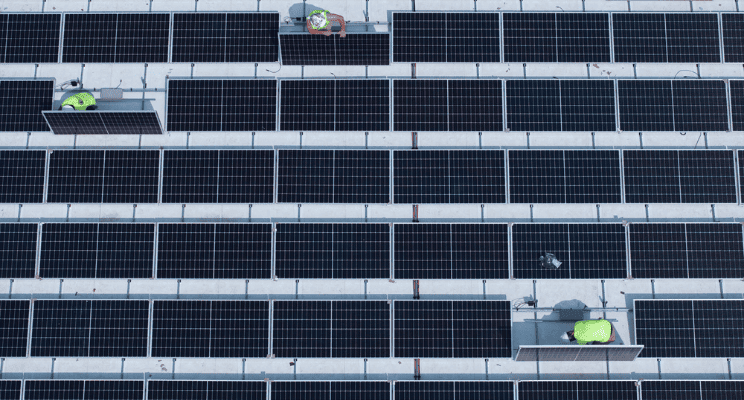Making Space for the Energy Transition

At Link Logistics, our purpose is to drive the U.S. economy forward by providing businesses with space to grow in our best-in-class industrial real estate properties. Lately, this mission has felt especially important when working with companies that are helping to steer the energy transition.
Scientists agree that transitioning to cleaner forms of energy is essential to maintaining conditions that allow people, communities and commerce to prosper. This societal-scale project is advancing rapidly. It also increasingly touches our firm’s buildings, representing a tailwind for our sector. More importantly, however, is this: The convergence perfectly encapsulates Link’s mission of using our real estate, data and supply chain solutions to propel sustainable prosperity and positive impact.
Onshoring meets clean energy
“Companies that make and distribute electric vehicles and EV parts such as lithium batteries more than doubled their leasing in the first quarter of the year compared with the same period last year,” The Wall Street Journal reported earlier in 2023. In the same article, I shared that Link Logistics has leased about 2 million square feet in recent quarters to companies that make solar panels, EV batteries, wind turbines, hydrogen fuel cells and other products essential to the switch to cleaner energy.
Across our national portfolio at Link, companies involved with the energy transition compose about 2.5-3 percent of our leasing activity over the past 12 months. This figure is up from almost zero a couple years ago. We expect it to increase substantially in the future. In fact, we are already seeing such companies make up a much larger share of our leasing activity in markets such as Dallas, Atlanta, Charlotte, Pennsylvania and the mid-Atlantic. The list of organizations using our space to progress the move to cleaner energy includes startups and specialized firms, as well as new business lines from established companies.
The energy transition also overlaps with the rise of onshoring and reshoring. Our Research & Analytics team at Link has tracked 54 clean energy manufacturing projects that have been announced for U.S. markets over the past two years. These projects include EVs, EV batteries and solar panels. They represent $110 billion of investment and are projected to create 110,000 new jobs. (Globally, $1.7 trillion is expected to be invested in clean energy technologies this year alone, according to the International Energy Agency.)
The details and implications of all of this are fascinating to us at Link.
Hot spots and spillover effects
Many of the domestic projects we have identified are in the growing “Battery Belt” of the Southeast and Midwest. When choosing new clean energy manufacturing sites, companies are most often drawn to infill locations, which are also a primary focus for us at Link Logistics. These considerations includeproximity to infrastructure such as ports, rails and major highways; proximity to essential materials, existing manufacturing facilities and suppliers; and proximity to skilled workforces.
The public sector is also involved. President Joe Biden has set a goal of having 50 percent of all new vehicle sales be electric by 2030 and the Inflation Reduction Act of 2022 was designed to accelerate the energy transition.
Moving manufacturing operations stateside reduces America’s reliance on foreign nations and should strengthen the clean energy transition in the U.S. There is also a spillover effect—when a company making EVs, for example, begins production in a new market, an ecosystem of companies that support that manufacturer often follows.
The companies that compose these ecosystems need space, too. Our internal research at Link shows that Savannah, Charleston, Louisville and Charlotte all rank high on the list of markets that will see the most spillover demand for real estate fueled by manufacturing and energy transition projects. Considering onshoring and reshoring as a whole, we estimate manufacturing and associated supplier networks to ultimately drive demand for nearly 500 million square feet of space.
Eager to keep playing our part
Even as we increase our partnerships with energy transition companies, we are enhancing our own energy efficiency to lower the carbon footprint of our firm and our customers. This includes initiatives such as building all new developments to LEED standards, installing solar capacity and LED lighting across our portfolio, and progressing toward our goal of reaching carbon neutral operations by 2025.
As we pursue our own sustainability targets, increasingly working with companies advancing the energy transition continues to be inspiring. It is humbling to know that we have our own small role to play in a project of such critical importance to society and future generations. This work is key to our overarching mission to drive long-term success for the economy, businesses and our communities.
At Link Logistics, we are eager to continue doing our part. Given our scale and focus on sustainability, we have developed core competencies across energy and utility disciplines that will allow customers to leverage our expertise as an extension of their teams. In addition to providing environmental benefits, our approach to decarbonization will also yield operational efficiencies and continue to drive value for our customers. In the near future, we look forward to sharing our analysis on the barriers to decarbonization and how Link is working to challenge the status quo.